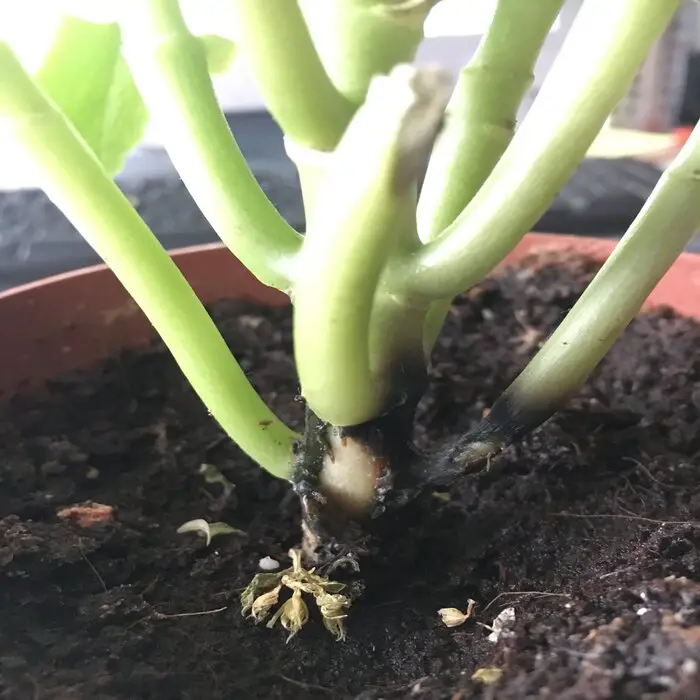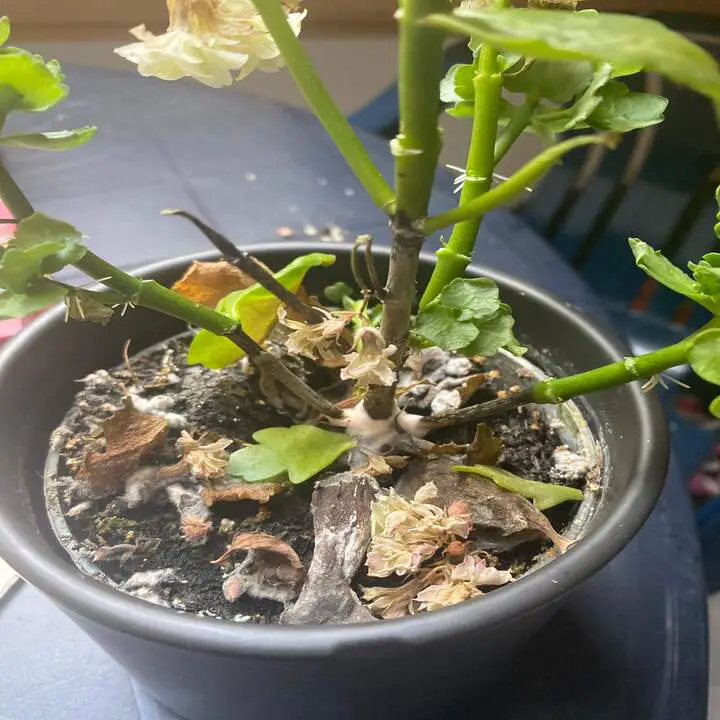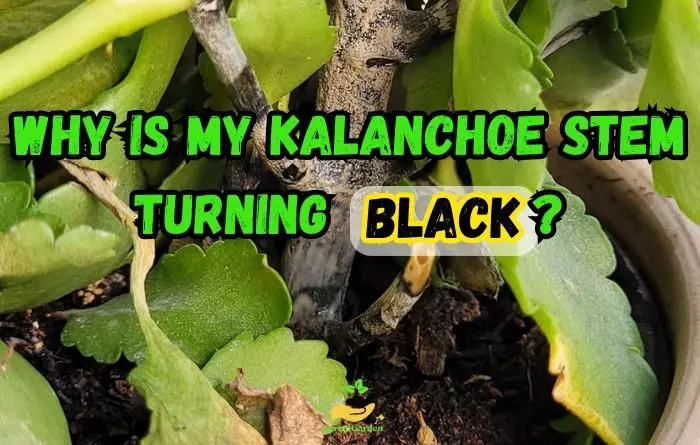Why is My Kalanchoe Stem Turning Black? (7 Causes)
Blackening of the stem on your Kalanchoe plant can be a cause for concern, but understanding the reasons behind it is crucial in effectively addressing the issue. If you have noticed black areas on the stems of your Kalanchoe plant, you may be wondering what is causing this discoloration and how to prevent it from spreading.
Kalanchoe stem is turning black due to factors like overwatering, poor soil drainage, cold temperatures, fungal infections like steam rot, and physical damage. Both overwatering and poor soil drainage can lead to root rot, while fungal infections block water and nutrient flow. To prevent this, maintain a balanced watering schedule and ensure proper drainage. If you notice blackening, consider trimming affected areas and using a homemade fungicide.
Causes of Kalanchoe Stem Turning Black
| Causes of Kalanchoe Stem Turning Black | Symptoms | Prevention |
|---|---|---|
| Overwatering | Blackening of stems, root rot | Provide well-draining soil, allow the top inch of soil to dry out between waterings |
| Fungal Infections | Black discoloration on stems, wilted leaves | Avoid overwatering, promote good air circulation, remove infected kalanchoe plant parts |
| Pests | Black spots on stems, presence of insects | Regularly inspect kalanchoe for pests, use appropriate pest control measures |
| Environmental Stressors | Wilting, yellowing of leaves, black discoloration on stems | Provide appropriate light, temperature, and humidity conditions |
1. Overwatering
The primary reason for a Kalanchoe stem turning black is due to excess irrigation, which can lead to root and stem rot. Fungi tend to form on the stem, blocking the supply of water and nutrients to the plant, and overwatering is often the culprit.
Solution
To prevent overwatering my kalanchoe, I’ve learned to:
- Adjust my watering schedule: Reducing watering, especially during the winter, helps the soil dry out between waterings. This, in turn, prevents issues like lethargic leaves, blackening, and stem softening.
- Practice moderate watering: I’ve found it crucial to strike the right balance between underwatering and overwatering to maintain the plant’s health.
- Ensure proper drainage: I make sure to use pots with good drainage to avoid water accumulation at the bottom, and I never leave excess water in the saucer beneath the pot.
| Season | Amount of Water Kalanchoe Needs |
|---|---|
| Spring | Water thoroughly when the top 1-2 inches of soil are dry |
| Summer | Water thoroughly when the top 1-2 inches of soil are dry |
| Fall | Water thoroughly when the top 1-2 inches of soil are dry |
| Winter | Water sparingly, only when the soil is completely dry |
By following these guidelines and maintaining the appropriate watering regimen, I can effectively protect my Kalanchoe from developing blackened stems and ensure its overall health.
2. Poor Soil Drainage
Poor soil drainage can lead to Kalanchoe stems turning black because it creates a waterlogged environment around the roots. As a succulent expert, I’ll explain why this happens and how to address it.
Here’s why poor drainage can cause problems to the kalanchoe stem:
- Root Suffocation: Excess water surrounding the roots can lead to suffocation. Kalanchoe roots require oxygen for optimal functioning, and waterlogged soil deprives them of this crucial element.
- Root Rot: Prolonged exposure to excessively wet conditions can cause the roots to rot. When the roots are compromised, they lose their ability to absorb water and nutrients, which has a negative impact on the overall health of the plant.
- Stem Damage: When the roots are affected, the plant’s ability to supply water and nutrients to the stems is impeded. Consequently, the stems may start to blacken and become soft or mushy.
- Reduced Vigor: Kalanchoe plants grown in poorly draining soil may display stunted growth, wilted or blackened stems, and an overall decline in health. They may also become more susceptible to diseases.
When the soil lacks proper drainage, it results in excess water accumulating at the base of the pot and saturating the soil. Kalanchoes, being typical succulents, thrive in well-draining soil that enables excess water to escape swiftly.
Solution
To fix poor soil drainage, I follow these steps:
- Repot in Well-Draining Soil: I begin by repotting my Kalanchoe in a well-draining succulent or cactus mix. These specialized soils are designed to prevent water from pooling around the roots. It’s important to choose a potting mix that contains materials like perlite or coarse sand to enhance drainage.
- Use Suitable Pots: I prefer pots with drainage holes at the bottom. These holes allow excess water to escape, reducing the risk of waterlogged soil. I also make sure the pot is appropriately sized for my Kalanchoe; it shouldn’t be overly large, as this can retain more water.
- Elevate the Pot: In cases where my pot lacks drainage holes, I elevate it within a slightly larger pot that does have drainage. This setup allows excess water to collect in the outer pot, maintaining the inner pot and soil in a well-drained condition.
3. Fungal Infections

Fungal infections can cause the kalanchoe stem to turn black by leading to root and stem rot. When a fungal infection occurs, it can block the supply of water and nutrients to the plant, which can cause the stem to turn black.
Here are some fungal diseases that I know will lead to stem turning black:
- Root Rot or Fungal Infection: If the blackened stem portions are affected by rot, it’s crucial to trim these areas. After cutting, allow the cut parts to dry and form a callus before replanting them in dry soil. Kalanchoe cuttings typically root well and can give rise to new plants. Alternatively, it could be a fungal infection, which might be addressed with a suitable fungicide like foundationazole if detected early.
- Gray Mold Infestation: Early-stage gray mold infestation might lead to stem blackening. This can be caused by excessive moisture-promoting mold growth. Reducing moisture and improving ventilation can help combat this issue.
- Stem Rot Due to Temperature Fluctuations: Stem rot can occur if Kalanchoe trunks dry out and turn black due to sharp temperature drops, particularly in winter. To manage this, it’s essential to maintain stable temperature conditions and avoid exposing the plant to severe cold.
- Fungus Infection (Phytophthora omnivora): If the black rot is due to a fungus like Phytophthora omnivora, it might have spread from using contaminated tools. Fungicide applications could be attempted, but if the rot has spread significantly, it might be more practical to replace the plant, as the treatment can be costly compared to the plant’s value.
Remember, early detection and prompt action are key to saving your Kalanchoe when it’s experiencing stem blackening.
If you notice a foul smell or the stems feel soft and rotting, it may indicate root rot as the culprit. Root rot is often caused by overwatering or poor drainage, leading to the roots being constantly wet and lacking oxygen.
4. Root Damage
I can tell you that the blackening of the kalanchoe stem can be due to root damage caused by changing the soil or repotting the plant, as well as microtrauma during transplantation. If roots are rotting, they may feel slimy to the touch and appear dark in color.
Here’s what I know:
- Root Damage during Repotting: Sometimes, when we change the soil or repot the Kalanchoe, the roots can get hurt. It’s essential to be gentle during this process. Rough handling can damage the roots, making the plant more susceptible to issues like stem blackening. So, I handle the roots with care, avoiding any tearing or breaking.
- Microtrauma and Fungal Infection: Sometimes, tiny injuries during transplanting or excessive watering can harm the delicate root tips, potentially causing trouble for the plant. When the roots start to rot, they often feel slimy to the touch and appear darker than usual.
- Moreover, any injury or wound in this succulent can provide an opening for fungi. While it’s not confirmed as a fungal infection unless the stem turns soft, it’s wise to keep a close eye on the plant. If you notice the blackening spreading, it’s a good practice to trim the affected part and treat the plant with a homemade fungicide. This fungicide can be made by mixing 3 tablespoons of 3% hydrogen peroxide with 1 liter of water.
Solution
When the stem turns black, and the kalanchoe is in poor condition, I prefer taking healthy side shoots, rooting them in a suitable medium like sand or perlite, and ensuring the soil is only slightly damp. Using a rooting agent can also be helpful.
To prevent these issues, I take the following steps:
- Gentle Transplanting: When repotting, I handle the roots delicately, avoiding any rough treatment that could lead to root damage.
- Well-Draining Soil: I always plant my Kalanchoe in a well-draining succulent or cactus mix. This type of soil helps prevent water from building up around the roots, reducing the risk of root rot and damage. I avoid heavy, water-retentive soils that can lead to root problems.
5. Cold temperatures
Cold temperatures can cause the kalanchoe stem to turn black by damaging the plant’s tissues and disrupting its normal growth processes. When the temperature drops below the kalanchoe’s ideal range, it can cause the plant to become stressed and vulnerable to disease and pests.
Cold temperatures can also cause the plant’s tissues to freeze, which can lead to cell damage and death. This can cause the stem to turn black and the kalanchoe to die.
Solution
To tackle this concern effectively, it’s crucial to exercise caution when it comes to watering the plant, allowing the soil to thoroughly dry out between waterings.
Abrupt fluctuations in air and soil temperatures can also contribute to the problem. Maintaining a consistent environment is key to keeping the plant healthy and preventing issues such as stem rot and leaf deformities.
While it’s true that exposure to cold, like when a window is left open, can potentially harm Kalanchoe, it’s not usually the primary cause of stem blackening. The primary focus should be on providing the right conditions in terms of light and temperature to shield the plant from harm.
| Kalanchoe Stage of Growth | Minimum Temperature | Maximum Temperature |
|---|---|---|
| Germination | 65°F (18°C) | 75°F (24°C) |
| Seedling | 60°F (16°C) | 75°F (24°C) |
| Vegetative Growth | 55°F (13°C) | 85°F (29°C) |
| Flowering | 60°F (16°C) | 75°F (24°C) |
| Dormancy | 50°F (10°C) | 60°F (16°C) |
https://ipm.missouri.edu/MEG/2017/1/Kalanchoe/
6. Excessive Sunlight
Kalanchoe plants are adapted to thrive in bright, indirect light, but they can suffer from sunburn if they are exposed to direct sunlight for too long. Sunburn will cause the stems to turn black and dry out, which can eventually lead to the death of the plant.
This is because excessive light can cause the plant to lose too much water through transpiration, which can lead to dehydration and tissue damage.
Solution
To prevent Kalanchoe stems from turning black due to excessive light:
- Provide Adequate Shade: Ensure the succulent is not exposed to direct, harsh sunlight. Use sheer curtains, shade cloth, or move the plant to a location with more filtered or indirect light.
- Monitor Light Levels: Be attentive to the plant’s light requirements and adjust its placement accordingly. Different species of Kalanchoe may have varying light preferences, so it’s important to know your specific variety.
- Control Temperature: In hot climates, provide the plant with some protection from extreme temperatures, especially during the hottest parts of the day.
7. Mealybugs Pests
Mealybugs, those tiny, soft-bodied insects, are not a friend to Kalanchoe plants. I’ve seen how these pests can cause those dreaded black marks on the stems.
Let me explain how:
- Feeding on Plant Sap: Mealybugs are like tiny sap-sucking vampires. They feed on the plant’s sap, which is like its life juice. When they do this, they damage the plant’s tissues, weakening it.
- Honeydew Secretion: As if that’s not bad enough, mealybugs secrete a sticky, sweet substance called honeydew. This stuff not only makes a mess but also attracts other pests and can lead to fungal infections. It’s like an open invitation for trouble.
- Disease Transmission: Mealybugs can be disease carriers too. They may pick up diseases from one plant and then spread them to your Kalanchoe. It’s like a chain reaction of problems.
When these mealybugs have their feast on the stem of a Kalanchoe, they disrupt the plant’s normal growth processes. This disruption can lead to the stem turning black, which is a clear sign that the plant is not happy.
So, keeping those mealybugs away is a big part of keeping our Kalanchoe healthy and vibrant.
Solution
Here are some solutions to deal with mealybugs on your Kalanchoe succulents:
- Isolation: If you notice mealybugs on one plant, isolate the affected plant to prevent the infestation from spreading to other plants.
- Manual Removal: Use a cotton swab or a soft brush dipped in rubbing alcohol to gently wipe away the mealybugs from the plant. Be thorough and make sure to get into all the nooks and crannies of the plant.
- Pruning: If the infestation is severe and concentrated on a particular part of the plant, consider pruning and removing the affected sections. Dispose of the pruned material properly.
- Insecticidal Soap: You can use insecticidal soap, which is a safe and effective way to control mealybugs. Follow the product instructions for application.
- Neem Oil: Neem oil is another natural remedy. Mix it with water according to the instructions on the product and spray it on your plant. Neem oil can disrupt the life cycle of mealybugs.
How to Prevent My Kalanchoe Stem from Turning Black

| Preventative Measures | Proactive Care Tips |
|---|---|
| Proper watering techniques | Use well-draining soil mix |
| Optimal lighting conditions | Maintain moderate humidity levels |
| Suitable soil types | Regularly inspect for pests |
| General plant care practices | Ensure adequate air circulation |
Preventing black stems on my Kalanchoe plant requires proactive measures and adherence to proper plant care practices.
By following these tips, you can minimize the risk of blackening stems and preserve the health and beauty of my Kalanchoe:
- Watering: Ensure that you water your Kalanchoe plant properly. Overwatering is a common cause of stem rot and blackening. Allow the top inch of soil to dry out between waterings, and always use well-draining soil to prevent waterlogged roots.
- Lighting: Kalanchoe plants thrive in bright, indirect sunlight. Place your plant near a window where it can receive adequate light, but avoid exposing it to direct sunlight, as this can scorch the leaves and stress the plant.
- Temperature: Maintain a consistent temperature for your Kalanchoe plant. These plants prefer temperatures between 60°F and 75°F (15°C-24°C). Avoid exposing them to extreme cold or hot conditions, as this can weaken the stems and make them more susceptible to blackening.
- Humidity: Kalanchoe plants prefer moderate humidity levels. If you live in a dry climate, consider using a humidifier or placing a tray of water near your plant to increase moisture in the air.
- Fertilization: Feed your Kalanchoe plant with a balanced, water-soluble fertilizer during the growing season. Follow the instructions on the fertilizer package for proper dilution and frequency. Avoid over-fertilizing, as this can lead to nutrient imbalances and affect stem health.
- Adequate Air Circulation: Proper air circulation is crucial for preventing fungal infections and maintaining stem health. Ensure that your Kalanchoe plant is not overcrowded and has enough space to breathe.
- Pruning: Regularly inspect your Kalanchoe plant for any signs of blackening stems or disease. If you spot any affected areas, promptly remove them by pruning with clean, sharp shears. This will help prevent the spread of disease and promote new growth.
- Pest Control: Regularly inspect your plant for common pests like aphids, mealybugs, or spider mites. If you spot any pests, treat them immediately with an appropriate insecticide or by using organic pest control methods.
Key Takeaways:
- Blackening of the stem on your Kalanchoe plant can be a sign of stem rot, overwatering, or other underlying issues.
- Identifying the cause of the blackening stems is essential in implementing the appropriate treatment.
- Treating root rot, managing fungal infections, and controlling pests are some of the remedies for blackened kalanchoe stems.
- Preventive measures such as proper watering techniques and optimal lighting conditions can help prevent black stem on Kalanchoe plants.
- Maintaining overall plant care practices, such as proper fertilization and regular inspections, can promote stem health and prevent blackening.
Conclusion
By following the advice and tips outlined in this article, you can effectively address the issue of blackening stems in your Kalanchoe plant and promote its overall health and longevity.
If you have noticed black areas on the stems of your Kalanchoe plant, it is important to take action promptly to prevent further damage and preserve the blooming buds. Cutting off the affected branch may seem like a logical step, but if the black areas reappear on other stems, it indicates a deeper underlying issue. This could be a result of root rot or overwatering, both of which can lead to the blackening of stems.
Frequently Asked Questions
Blackening stems can affect the overall health of your Kalanchoe plant. It may hinder the plant’s ability to thrive, flower, and grow. Recognizing the symptoms associated with blackened stems can help you take necessary steps to prevent further damage.
To identify the root cause of blackening stems in your Kalanchoe plant, examine the plant for signs of disease, pests, or environmental factors. It is important to accurately pinpoint the underlying problem before implementing the appropriate treatment.
Some Kalanchoe stem care tips include proper watering techniques, consideration of light requirements, maintaining suitable temperatures, fertilization, and overall plant maintenance. Following these tips can promote healthy stems and overall plant health.
If you suspect that your kalanchoe plant has root rot, there are several signs to look out for. One of the most common signs of root rot is a foul odor coming from the soil. Additionally, the plant’s leaves may start to turn yellow or brown, and the plant may start to wilt or droop. If you gently tug on the plant, you may notice that the roots are soft, mushy, or discolored.




